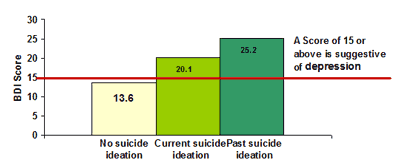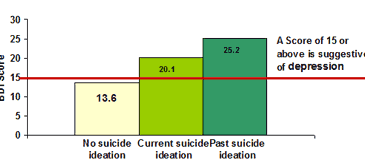Suicide is a public health problem that popular culture frequently associates with gambling. There is evidence linking gambling to potential risks for suicide such as financial problems, marital tension, and job loss (Bergh & Kuehlhorn, 1994; Ladouceur, Arsenault, Dube, Freeston, & Jacques, 1997). However, due in part to the difficulty of identifying the primary cause of a suicide, researchers have been unable to correlate changes in suicide rates to changes in problem gambling rates (see WAGER 7(35) for a review). The relationship between suicide and gambling is important and The WAGER will continue to cover new studies on this topic as they emerge. This week’s WAGER reports on a study that examined suicidal ideation in a population of pathological gamblers (Blaszczynski & Maccallum, 2003).
Researchers interviewed 85 (57 male) consecutive treatment-seeking pathological gamblers (i.e., met DSM-IV criteria). Each participant completed a clinical entrance interview and three self-report measures: the South Oaks Gambling Screen (SOGS, Lesieur & Blume, 1987), the Beck Depression Inventory (BDI, Beck & Steer, 1987), and the Beck Scale for Suicide Ideation (BSS, Beck & Steer, 1993).
During their entrance interview, thirty-one participants (36%) reported experiencing suicidal ideation associated with their gambling in their lifetime: 20 participants reported a past history of suicidal ideation due to gambling, 2 reported current suicidal ideation (active suicide ideation in the prior 24 hours) due to gambling, and 9 reported both current and past suicidal ideation due to gambling. Of the 31 people who considered suicide, 13 had formed specific suicide plans and 10 of these participants had taken active steps to prepare for their suicide (e.g., writing a suicide note or selling property). There were seven people who actually attempted suicide, three attributed their attempts to gambling problems and four attributed them to unrelated reasons.
Overall there was a significant difference in Beck Depression Inventory scores between suicide ideation groups (F(2,82) = 10.53, p<.001). Post hoc analyses showed that participants who reported no suicide ideation scored significantly lower on the BDI than participants with current or past suicide ideation (Figure 1). SOGS scores were not significantly different for participants with current suicide ideation and participants without any suicide ideation. A multiple regression analysis identified BDI depression score, urge to gamble and a lower rating of self-control as predictive of suicidal ideation (F(3, 81) = 16.86<.001, R=.62, R2=.38).
Figure 1. Mean Depression (BDI) Scores by Suicidal Ideation Group

The prevalence of suicidal ideation and suicide attempts in the general population has been estimated at 5-18% and 1-5% respectively (Statham et al., 1998). The Blaszczynski and Maccallum study demonstrated more suicide ideation (36%) and suicide attempts (8%) among a population of treatment-seeking problem gamblers. Gamblers reporting suicidal ideation were more likely to be depressed and had higher scores on the Beck scale; however, they did not report more gambling problems. This suggests that depression and other risk factors might be more associated with the increased suicide ideation observed than gambling patterns. However, the causal relationship remains elusive. For example, if the problems that resulted from pathological gambling induced depression, then gambling would play the primary causal role. Alternatively, if depression preceded gambling and stimulated the observed suicide ideation, then gambling might not play a major causal role. Further, although participants self-reported that their suicidality was due to gambling, they were all entering treatment for pathological gambling at the time of their interview and were focused on this problem during the interview; hence, participants might unintentionally have over-attributed causality to gambling rather than depression. Longitudinal research is needed to tease out the exact nature of the relationship between gambling, depression, and suicide.
Although it is difficult to establish a causal link between gambling and suicide, this topic is deserving of continuing attention. Suicide is an avoidable public health problem. The present study identifies a high level of depression among pathological gamblers. This can be interpreted to suggest that this commonality might play a role in suicide ideation. Next week, The WAGER will take a closer look at the relationship between problem gambling, depression, and suicide.
Comments on this article can be addressed to Rachel Kidman.
References
Beck, A., & Steer, R. (1987). Manual for the revised Beck Depression Inventory. San Antonio, Tx: The Psychological Corporation.
Beck, A., & Steer, R. (1993). Beck Scale for Suicide Ideation. San Antonio, Tx: The Psychological Corporation.
Bergh, C., & Kuehlhorn, E. (1994). Social, psychological and physical consequences of pathological gambling in Sweden. Journal of Gambling Studies, 10(3), 275-285.
Blaszczynski, A., & Maccallum, F. (2003). Pathological gambling and suicidality: An analysis of severity and lethality. Suicide and Life-Threatening Behavior, 33(1), 88.
Ladouceur, R., Arsenault, C., Dube, D., Freeston, M. H., & Jacques, C. (1997). Psychological characteristics of volunteers in studies on gambling. Journal of Gambling Studies, 13(1), 69-84.
Lesieur, H. R., & Blume, S. B. (1987). The South Oaks gambling screen (SOGS): A new instrument for the identification of pathological gamblers. American Journal of Psychiatry, 144(9), 1184-1188.
Statham, D., Health, A., Madden, P., Bucholz, K., Bierut, L., Dinwiddie, S., et al. (1998). Suicide behaviour: an epidemiological and genetic study. Psychological Medicine, 29, 9-17.




